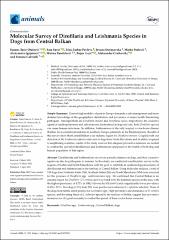| dc.description.abstract | Dirofilariosis and leishmaniosis are severe parasitic diseases in dogs, and their causative
agents can also be pathogenic to humans. In this study, we conducted a multicentric survey in the
regions of Serbia and North Macedonia with the goal to establish an epidemiological scenario of
dirofilariosis and leishmaniosis in the territory of Central Balkan. Using molecular analyses, a total of
535 dogs from Northern Serbia (NS), Southern Serbia (SS) and North Macedonia (NM) were screened
for the presence of Dirofilaria spp. and Leishmania spp. We confirmed that Central Balkan is an
endemic region for Dirofilaria (D.) immitis, as it was found to be the dominant species in this area, with
the highest prevalence of 8.75% in NM, followed by NS (6.68%) and a significantly lower prevalence
in SS (1.51%). Two dogs (2.5%) from NM were positive for Leishmania (L.) infantum infection. None of
the dogs from Serbia tested positive for Leishmania spp. High prevalence and dominance of D. immitis
species, and the rising threat of L. infantum spread to the territory of Serbia, suggest that preventive
measures are of a great necessity to combat the spread of these vector-borne zoonoses. | en_US |

